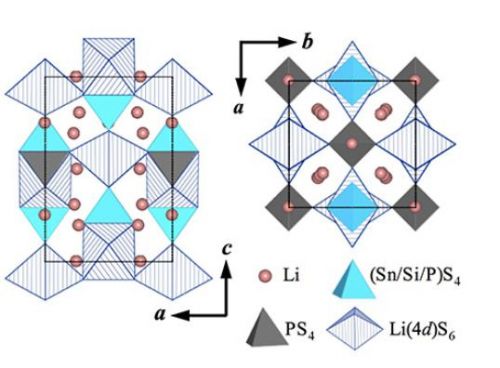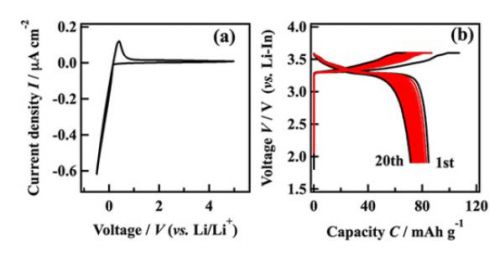According to foreign media reports, researchers at the Tokyo Institute of Technology have developed a new technology solution - flawless solid electrolyte, which can reduce the cost of solid-state lithium batteries and is committed to applying this technology to electric vehicles. , communications and other industries.
Innocent solid electrolyte
The research team published a paper in the Journal of the American Chemical Society (ACS), Chemistry of Materials, which uses tin and silicon instead of germanium in solid electrolytes because of the above. Both materials are more chemically stable. Compared to liquid electrolytes, new materials increase the conductivity of lithium ions. When talking about his research, Ryoji Kanno and his colleagues said: "This solid electrolyte does not contain antimony, and it may be used in all solid-state batteries in the future."
An all-solid-state battery system with solid electrolytes (SEs) is expected to compete for a new generation of batteries. It is estimated that this type of battery can provide large power, high energy density, stable performance, and improved safety performance. Sulfide-based lithium-ion conductors have high electrical conductivity, electrochemical window (also known as "potential range") and mechanical properties. To this end, many organizations are currently vigorously developing solid electrolytes.
Li10GeP2S12 (LGPS) is a new member of the Crystal Sulfur Electrolyte product line with conductivity of 1.2 × 10?2 S cm?1, comparable to organic liquid electrolytes. The all-solid-state battery LiCoO2/LGPS/In?Li uses LGPS electrolyte, and its charge and discharge performance is quite excellent. However, the elemental price is relatively expensive, or it will limit the widespread use of LGPS materials.
The type of crystal structure is also an important factor in the design of lithium ion conductors. If the materials of different materials are similar in type and the conductivity of the solid is high, the conductivity of the new material will be better. The LGPS-like structure has a high lithium ion diffusivity. In the future, both silicon-based and tin-based materials can be used as solid electrolytes and put into practical use.

The atomic arrangement of the new material is named LSRSS. The result of the new flawless material was Li10.35[Sn0.27Si1.08]P1.65S12 (Li3.45[Sn0.09Si0.36]P0.55S4.
The advantages of all solid state batteries
Compared with common lithium-ion batteries using lithium-ion conductive liquids, future all-solid-state batteries have the following advantages: improved safety and reliability, higher energy storage and longer service life.
Superionic conductors - Solid crystals have found that the rate of movement of lithium ions has increased, which has led to the development of such batteries, but this promising design was once dependent on rare metals. The application of é”— is too large to be used for large-scale applications.
According to Kanno, due to its high chemical stability and ease of assembly, this new material enhances the possibility of fine-tuning solid electrolytes to meet a variety of industrial and consumer needs.
In 2011, Kanno and his team members collaborated with Toyota Motor and Japan's High Energy Acceleration Research Institute (KEK) to introduce a solid electrolyte with a structure of Li10GeP2S12 (LGPS). The material has taken the lead in the development of pure solid-state batteries, and the team has also developed other solid-state electrolytes based on the LGPS structure and achieved results.
Optimize LGPS frame structure to improve performance
In a recent paper, the researchers retained the same LGPS frame structure to fine-tune the rate and positional distribution of atoms in tin, silicon, and other components. The research results of the LSPSS material (component: Li10.35[Sn0.27Si1.08]P1.65S12 (Li3.45[Sn0.09Si0.36]P0.55S4)) have a lithium ion conductivity of 1.1 x 10- at room temperature. 2 S cm-1, almost close to the performance of the original LGPS structure.
Although further adjustments are needed, researchers can optimize material properties for their different uses, creating new hopes for lowering production costs without sacrificing material performance.

Cyclic voltammogram and charge and discharge curves. The material has high stability and strong charge and discharge capability, and its capacity retention is high in 20 charge and discharge cycles.
Unlike disposable e-cigarette, vape pod system is designed with vape device and disposable vape pod, which is detachable. Usually latest pod system includes one vape battery device and 3 pods(2ml), magnetic connector between pod and device, 1s pop in.
The processing technology for pod system has been greatly upgraded, the shell adopts oxidation and radium carving technology. The drip tip is made of PCTG food grade material. Moreover the e-cigarette pod system is designed under principle of ergonomics, so that you can feel comfortable, exact fitting when hold and inhale
The e-cigarette is available in dark gray, purple, blue, pink colors, with black electronic cigarette holder, environmentally friendly and full of youthful.
350mAh battery, charged by typc-c, 2ml e juice prefilled, enjoy happy vape all day long.
The M2 e-cigarette kit adopts triple oil leakage prevention design: top and bottom have multiple silica gel, used for rapid absorption of condensate; The middle layer uses the third generation of high density impervious ceramic coil, so that prevent oil leaking from atomizer
Multiple flavors available, apple ice, orange ice, tobacco, grape...... more than 13 fruits choice; 3.0 ceramic atomizing technology provides not only big vapor, but also smooth and delicate taste.
Vape Pod,Vape Pen Disposable,Vape Flavour,Vape Kits,Liquid Vape
Shenzhen Axiswell Technology Co., Ltd , https://www.medhealthycare.com
